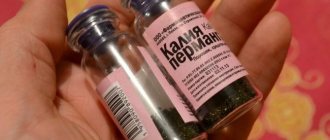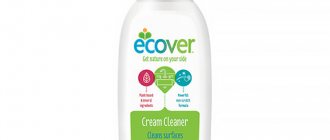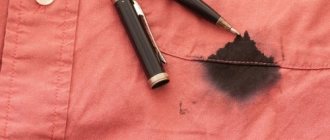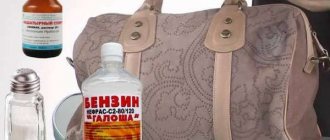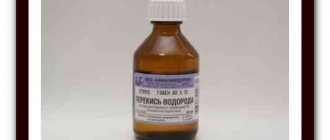Potassium permanganate or potassium permanganate has become firmly established in our everyday life and is used everywhere to disinfect and disinfect wounds and various solutions. It is used in agriculture and is even added to bath water for babies.
Potassium permanganate is a chemically active substance with a strong oxidizing effect. That is why, a few minutes after it hits any surface, the potassium permanganate stain turns from violet-burgundy to brown. You just can’t wash it off with water or remove it; it seems like it’s stuck forever. But still, there are means to remove such stains.
Basic methods for cleaning surfaces
If you start cleaning the bathtub from potassium permanganate while the stain is fresh, you can remove it quite easily and quickly than an old one.
To clean the bathroom from manganese deposits, modern cleaning products are used, which are sold in the store, but you can also use traditional methods. For example, try to scrub with soda, acetic acid, citric acid, oxalic acid, etc. Let’s take a closer look at the main methods of removing stains from both the bathtub and the sink. Baking soda does an excellent job of removing problem areas after potassium permanganate and gives the bath a snow-white appearance. You need to follow these steps:
- Wash the bathtub or sink first.
- Then sprinkle the stain generously with baking soda and wait 20 minutes. To clean the bathtub, you can use a sponge and wipe the dirty areas with it.
- After the specified time, rinse the bathtub with water.
It may happen that the stain does not disappear the first time, in which case it is necessary to repeat the procedure. If the bathtub is made of acrylic, then cleaning with soda is not recommended.
Bleach for white clothes will also help deal with this problem. To use it correctly, you should do the following:
- You need to fill the bath with warm water. The water level should be such that the stain is completely covered.
- Add a little alkaline bleach or oxygen bleach for white fabrics and leave overnight.
- After at least 10 hours, wipe the contaminated area with a sponge and drain the water.
- The bathtub must be thoroughly rinsed with tap water.
Moreover, if the stain could not be removed the first time, then the procedure must be repeated, slightly increasing the concentration of bleach.
Oxalic acid from traces of potassium permanganate
The use of naturally occurring acids is one of the effective ways to deal with unpleasant plaque. Usually some version of acid - oxalic, acetic, citric - will still be found on the farm.
Oxalic acid is more effective in combating residues from a manganese solution. To maximize the effect of its use, you must take the following steps:
- Pour about 200 ml of warm boiled water into a clean container.
- Add 1 tsp. oxalic acid and stir thoroughly.
- The bath must first be rinsed with warm water.
- It is necessary to moisten a soft sponge with the resulting solution and thoroughly wipe the surface with the stain.
- You should wait at least half an hour before rinsing off the solution with warm water.
- Repeat the procedure until the stain disappears.
Application of lemon solution
Citric acid also helps to cope with both fresh and old stains from potassium permanganate. However, to achieve the desired cleaning effect, the solution with citric acid must be kept for at least 15 hours. It is used as follows:
- In a clean container, dilute 200-250 ml of water and add citric acid.
- Dampen the sponge in the resulting solution and thoroughly wipe the contaminated areas of the plumbing.
- Fill the bath with warm water so that the water completely covers the stain, add 5 tbsp. l. citric acid and mix everything until the citric acid is completely dissolved.
- Leave for at least 15 hours and then thoroughly wipe the contaminated surface with a soft sponge.
- Drain the water and rinse the bathtub with running water.
After the procedure, the bathroom should shine like new.
Using vinegar to remove dirt
Acetic acid is common in any home. It will help with contamination with potassium permanganate and to give the bath a radiant whiteness. It must be used as follows:
- In a clean container, prepare a weak solution of acetic acid.
- Soak a clean sponge in the solution and thoroughly wipe the surface of the bath with traces of potassium permanganate.
- Fill the bath with warm water and dissolve 2 tbsp in it. l. acetic acid.
- Leave for at least 7 hours, then drain the water and rinse the bath thoroughly with clean running water.
A simple solution using laundry soap will also help remove stains on plumbing fixtures. To do this, pre-grated laundry soap is dissolved in 1 liter of hot water, then the mixture should be beaten until smooth. Then add 2 tbsp. l. soda The resulting mixture should be applied to the surface and left for an average of 10 minutes. The remedy will be even more effective if you add 2 tbsp. l. ammonia.
Cleaning products for potassium permanganate
Both chemicals and proven folk remedies are suitable for cleaning areas of this plumbing. This list includes:
- baking soda;
- oxygen bleach;
- oxalic acid;
- hydrogen peroxide;
- low concentration table vinegar;
- acrylic bath repair kit;
- CIF, Domestos, Amway, etc.
Household chemicals
An effective way is soaking. The technological process is as follows:
- Fill a container with warm water to the brim;
- Add oxygen bleach (CIF, Domestos, Amway);
- Leave for 30 minutes;
- Drain the water, while lightly wiping the surface with a sponge to remove any remaining traces of potassium permanganate.
Folk compositions
To remove brown stains from potassium permanganate, you need to do the following:
- It is necessary to dissolve vinegar in water (take 1 tsp per 100 g);
- Dampen a sponge (rag) in the solution;
- Rub contaminated areas;
- Leave for half an hour;
- Rinse with hot water, then with a warm stream of water;
- Repeat the process if traces of potassium permanganate have not completely disappeared.
A product that works well for removing dark spots is hydrogen peroxide. Use the following method:
- You need to moisten the sponge in the product;
- Rub the stains;
- Wait twenty minutes;
- Rinse off with warm water.
To clean the surface of plumbing fixtures from various stains, use regular soda. It is used for bleaching plumbing fixtures made of cast iron and metal. Next method:
- Wet the inside of the container;
- Wet the sponge;
- Dip it in soda;
- Rub brown spots;
- Rinse the entire surface with water.
How to free a bathtub from plaque
Bathtubs especially often suffer from manganese solution. This is due to the fact that some parents still follow the advice of pediatricians, who, in the old fashioned way, recommend bathing newborn babies in it. There are also bathtubs damaged in this way by the previous owners of the apartment. Therefore, the question of removing gray-brown plaque from coating materials, which is observed on “old Soviet” bathtubs, is the most common.
The surface you have to work with is quite extensive. In order to achieve success and not harm yourself, you must adhere to certain rules:
- When using any means, it is important to remember safety precautions and carry out all work only with rubber gloves.
- To clean even a heavily soiled bathtub, use only a soft sponge, since a metal sponge can severely damage the surface.
- Do not attempt to clean your bathtub with chlorine as this may damage the enamel.
- If the first time it was not possible to clean the potassium permanganate stain, then it is worth repeating the cleaning procedure, while increasing the concentration of the cleaning agent and applying it for a longer time.
- When cleaning the bathtub, do not vigorously rub stains, as this will lead to scratches and cracks in the product.
- Soda as a cleaner is suitable for all types of bathtubs, except acrylic, and copes well with potassium permanganate stains.
Purchased funds
You can get rid of colored plaque with the help of special preparations, which are easily purchased in the household department of the store. The most budget-friendly option would be traditional bleach, although it must be used carefully, since the aggressive effects of the chemical can damage the structure of the surface of the bathtub bowl. Stain removers will be effective. Application mechanism:
- Fill the bath to the brim with warm water.
- Pour in the required amount of the active ingredient and leave for 12 hours.
- When the time is up, drain the liquid and rinse the bowl thoroughly with strong pressure of running water.
If the procedure did not lead to the desired result, experienced users recommend increasing the concentration of the cleaner or using another product.
You can use chemicals that are specifically designed to remove difficult stains when cleaning the bathroom. Examples of funds:
You can purchase household chemicals for bathrooms.
- Domestos for baths;
- Cillit Beng for rust and plaque;
- Sarma for plumbing;
- Amway is a sulfate-free cleaner.
Before purchasing a specific product, you should study the instructions in detail, since each type of bathtub has its own specifics for care and cleaning. For example, an acrylic bathtub requires the use of special products for acrylic. The binding rule of care for all types of bowls is the ban on the use of abrasive powders and the use of metal brushes.
Removing stains from clothes
A stain from potassium permanganate is a real chemical burn of fabric, which destroys the top layer of the material.
To solve the question of how to wash potassium permanganate from clothes, you should turn to acids: acetic, oxalic and citric.
To clean clothes made from natural fabrics, you can use the following recommendations:
- Pour a little 9% vinegar onto the stain, and then hydrogen peroxide. After a few minutes, not a trace of contamination should remain, since acetic acid reacts with potassium permanganate and is neutralized.
- To remove traces of potassium permanganate from light-colored clothing, the following recipe is suitable: 1 tsp. oxalic acid must be poured into 100 ml of cold water. Apply the resulting solution to the problem area, leave for at least 30 minutes and rinse.
- Wet the stained surface with water and sprinkle a small amount of citric acid. After 15 minutes, rinse with water. Citric acid can be purchased at a regular store, but it is considered one of the best stain cleaners and helps remove even old stains from clothes.
If the task is to remove potassium permanganate from clothes made of wool and silk, then it is necessary to use more gentle methods for removing stains. For example, we soak it in yogurt or whey, using soda or ammonia.
To clean a woolen item, place it in a container with yogurt or sour milk for 4 hours, then rinse and wash in the washing machine on a normal cycle with washing powder.
It is advisable to purchase homemade yogurt at the market. The stain can be easily cleaned with the help of baking soda, which is available in every home. For this, 1 tsp. Apply baking soda diluted in water to the problem area, leave for a while and rinse. For items made of thin fabrics, you can use a weak solution of hydrogen peroxide, apply it to the stain, and after 15 minutes rinse with warm water. If the question is how to wash potassium permanganate from white clothes, then you should use the method below.
To prepare a solution that will help remove stains from clothes, you need to dilute 5 tbsp in 5 liters of water. l. soda and 2 tbsp. l. ammonia. The soiled item should be boiled in this solution and then washed thoroughly. The colored item is soaked in the solution for a while and then rinsed thoroughly. This method of removing stains does not affect the structure of the fabric and you don’t have to worry about the item becoming fragile and falling apart.
Features of pollution
Potassium permanganate, or potassium permanganate, is a universal antiseptic that is used to disinfect wounds and planting material. All you need to prepare the solution is stir the pink powder in water. When using an antiseptic, accidents happen and the liquid ends up on the floor, clothes and furniture.
Manganese solution stains cannot be washed off with water or cleaning agents. And a strong concentrate generally destroys the upper layers of the fabric, as if burning the fibers.
Manganese cannot be washed from clothes even with the most expensive powders and bleaches. It is recommended to use acids for cleaning.
Method for removing stains from linoleum
If the question arises about how to remove potassium permanganate from linoleum, it is also recommended to pay attention to citric and acetic acid. Before using these products, you should give regular baking soda a chance. If soda does not help clean the linoleum from potassium permanganate, then you can prepare a solution of citric acid dissolved in hydrogen peroxide and wipe the linoleum with it for 5 minutes, and then rinse with water. This method is also effective in removing stains from dishes.
Potassium permanganate is used quite often in everyday life. As an excellent antiseptic: for disinfecting wounds and cuts, seeds, food, etc. Putting a stain on clothes will not be difficult for anyone, but removing it is problematic.
In the fight against stains, it is important to remember that it is easier to remove a fresh stain than an older potassium permanganate stain that has become firmly embedded in the surface. Tips and tricks will help you cope with any problem associated with residues from a common disinfectant.
Baths with potassium permanganate
Taking baths with the addition of potassium permanganate is an effective medical procedure that is used mainly for children. It is used in the presence of certain skin diseases and wounds on the body. Such baths are also used by adults in similar cases, as well as in the treatment and prevention of hemorrhoids.
Children are bathed in special small baths, but adults take regular baths with the addition of potassium permanganate. Regardless of the volume of the container, a characteristic coating quickly forms on its surface. After 2-3 sessions, the plaque becomes stable. We advise you not to let it get to this point, but to take action quickly. A dirty bath or tub is, at a minimum, unhygienic, which calls into question the medical meaning of the procedures.
